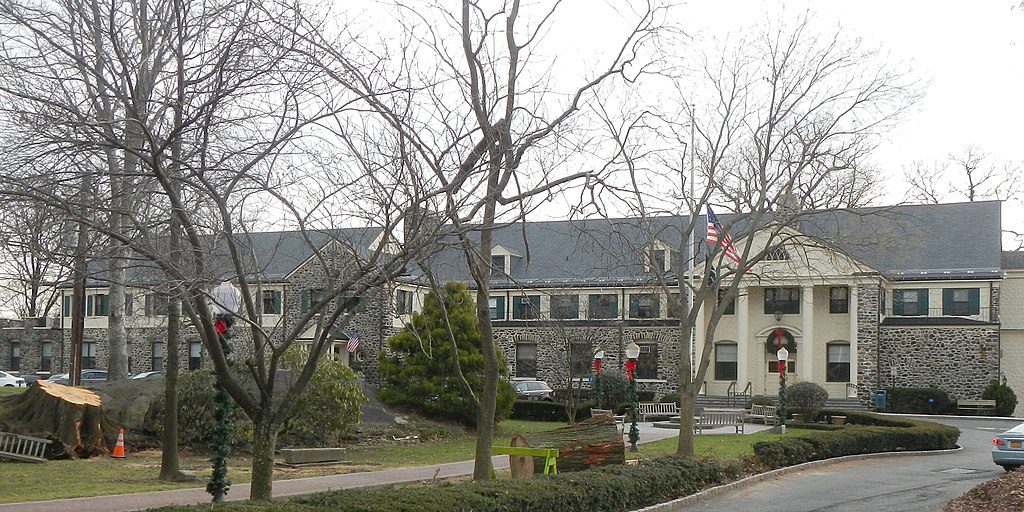
Eastchester Town Hall in New York. Photo by Jim Henderson, via Wikimedia Commons
In 2019, Shelterforce published an article that looked at the debates over community preference policies, which gives existing residents priority to subsidized housing built in their neighborhoods. Proponents call these policies an important bulwark against displacement and an assurance that longtime residents can benefit from investment in their communities. Opponents call them obstacles to fair housing that make it harder for low-income residents to move out of segregated neighborhoods.
A development in Eastchester, New York, shows the potential dark side of such policies when they are applied not in communities facing the potential for displacement, but in communities that are currently exclusive, well-off, and majority white.
The story started on Nov. 21, 2016, when the Fair Housing Justice Center (FHJC) filed a federal lawsuit alleging that the Town of Eastchester, which is predominantly white, used residency preferences to suppress participation by people of color in the town’s Section 8 Housing Choice Voucher Program and senior housing developments. The policy put applicants who did not already live or work in the town onto a waiting list until all current residents had been accepted. Furthermore, the town prioritized residents based on length of residency, which also favored white households over Black or Latinx households. Town officials also did not advertise that those who worked in the town were eligible for the residency preference.
“The federal Fair Housing Act prohibits predominantly white suburban communities like Eastchester from adopting and enforcing policies in land-use, zoning, or affordable housing programs that effectively exclude or limit access to housing opportunities based on race or national origin,” stated FHJC Executive Director Fred Freiber in a release.
[RELATED ARTICLE: Criticisms About Community Preference Policies Are Misguided]
In October 2020, Judge Vincent L. Briccetti found that there were “questions of fact as to whether the town’s residency preference will have an adverse disparate impact on Black and Hispanic renters and buyers” and noted that “the town had never received approval from HUD of the town’s use of residency preferences in its Section 8 program.” In one HUD-subsidized Eastchester senior development, 95 percent of its more than 100 tenants were white, with only 1 Black tenant. FHJC expert Justin Steil notes that “assuming a randomized applicant pool that reflects the demographics of Westchester County—the marketing region identified by defendant itself—the likely application pool for senior housing . . . in Eastchester will be 70 percent white and 30 percent nonwhite. But with the town’s residency preference . . . the recipients of such housing would likely mirror the demographics of the town age 55 and over: namely, 91 percent white and 9 percent nonwhite.”
The town closed its Section 8 program due to the controversy in 2019, but the court held that FHJC’s claims of intentional discrimination was backed by evidence gathered from community meetings where residents expressed fear that affordable housing developments would turn the town into “a Bronx neighborhood” and that “more Section 8 people will come in.” Briccetti maintained that “a reasonable factfinder could conclude that the town was motivated, at least in part, by its residents’ fears of racial integration when it enacted the senior housing law and residency preference.”
The judge’s 2020 decision allows FHJC to proceed with its case against Eastchester for racial discriminatory housing practices.
|
While this piece is free to read, it’s not free to produce. Please consider supporting our small and dedicated team on Patreon. |




I don’t think anyone seriously contests the idea that a preference policy run by a largely white suburban community is both intended to be exclusionary and is exclusionary in its impact. White communities have used this tactic of prioritizing their own residents for many decades in an attempt to limit racial diversity. Such initiatives offend both the law and moral standards. As obvious as all of that is, it is equally obvious that we should be able to make a distinction in policy and law between such initiatives and the preference policies being pursued by cities like SF, Portland, New York, Minneapolis and others that are aimed at minimizing displacement and allowing people to remain in neighborhoods and communities that they value.
Far too often, nuance is a foreign concept to public policy advocates and drafters of legislation.
There is no “bright” side to community preference policies IF they serve to exclude non-resident populations based on race and/or national origin and perpetuate residential segregation. The Community Board Preference policy that is applied to housing in New York City is also discriminatory. Illegal housing discrimination is not and should never be an anti-displacement policy.
Fred Freiberg, Executive Director
Fair Housing Justice Center
Where did all the Black residents of SF go? To the formerly white suburbs of Vallejo, Antioch, Tracy, etc.. And the resulting spike in crime is no coincidence.
You can’t have it both ways. Desire to maintain a community while working to displace people in others. It would seem, just by looking at the demographic numbers, the community’s acceptance rate would be shifting as the residents age out. Basically, Black communities in cites are being destroyed, Black population in SF has been decimated, in order to spread the black poverty problem to the suburbs. Thereby, permitting the white liberal, and special people, to create their own city enclaves, devoid of the Black people problem.